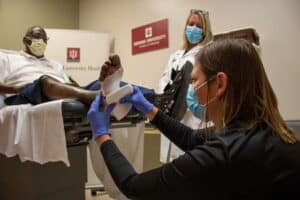Reprinted with permission from IU School of Medicine
 INDIANAPOLIS—Results from a new study of diabetic foot ulcers and the risk of wound recurrence show that a new approach can help health care workers measure the likelihood that the wound will reopen in the future. Researchers say these findings are likely to lead to further studies aimed at decreasing amputation rates for the tens of millions of people with diabetes in the United States. The study was led by Indiana University School of Medicine.
INDIANAPOLIS—Results from a new study of diabetic foot ulcers and the risk of wound recurrence show that a new approach can help health care workers measure the likelihood that the wound will reopen in the future. Researchers say these findings are likely to lead to further studies aimed at decreasing amputation rates for the tens of millions of people with diabetes in the United States. The study was led by Indiana University School of Medicine.
“Diabetic foot ulcers develop in diabetic patients with diabetic neuropathy, a condition which causes numbness in the foot,” said Chandan Sen, PhD, Distinguished Professor and J Stanley Battersby Chair of Surgery at IU School of Medicine. “The nerves in the skin become dysfunctional, which can cause patients to injure the affected foot without feeling it. Those untreated wounds can lead to infections, and if an infection is not treated quickly, an amputation may be necessary.”
Sen is the principal investigator of the transepidermal water loss (TEWL) trial of the Diabetic Foot Consortium, which includes seven sites across the country. It’s the first consortium for diabetic foot ulcers in the U.S. and is funded by the National Institute of Diabetes and Digestive and Kidney Diseases (NIDDK), with IU serving as the lead site for this study.
Patients who participated in this initial clinical study all experienced diabetic foot ulcers that had healed. The goal of the study was to identify a biomarker that would predict recurrence during the process of standard wound care. The approach involves measuring transepidermal water loss (TEWL), or how much bodily fluid is leaking through the skin, using a small pen-like device. The study lasted 16 weeks past closure of the wound.
Researchers found those with a high TEWL reading (>30 grams per meter squared per hour), signifying poor skin barrier function, had twice the incidence of wound recurrence compared to those with a low TEWL reading (<30g.m-2.h-1). In addition, participants’ self-reported recurrence was highly concordant with clinician assessment of wound recurrence. Although TEWL was not validated as a biomarker in this study, findings of the study are an important advancement in that direction.
Sen presented the study results June 25 at the American Diabetes Association annual meeting.
“The U.S. Food and Drug Administration definition of wound closure is covering of the wound with no discharge for two consecutive weeks,” Sen said. “This definition pays attention to structural covering of the wound defect, but does not address the functionality of the new skin that grew to close the defect. The primary function of the skin is to establish a barrier function to protect the inside of our body from external threats, such as pathogens and allergens, as well as help trap moisture inside the body so bodily fluids do not dry up.”
Sen said wound recurrence is a major health care cost burden, but this method of measuring TEWL is easy for health care providers to use with just 30 minutes of training.
“This is a transformative scientific discovery that will help further efforts to validate the biomarker and therefore improve the quality of life of patients with diabetes,” Sen said. “We look forward to future studies of this method that will ultimately lead to new clinical practices to help patients all over the world.”
“When wound care providers can identify patients at risk for recurrence of their diabetic foot ulcer, they can modify the treatment plan for that patient,” said Gayle Gordillo, MD, an investigator on this study, professor and chief of the IU School of Medicine Division of Plastic Surgery, and medical director of Wound Services for Indiana University Health. “For example, they may continue to monitor the patient in their office even though the wound looks healed. Presumably, the more information providers have to monitor the risks of diabetic foot ulcer formation the better the healing outcomes. This is highly significant because approximately 80 percent of lower extremity amputations in patients with diabetes are preceded by foot ulcers.”
“This consortium was designed to address a major research gap by finding ways to predict healing and recurrence of diabetic foot ulcers with the goal of effective therapies and prevention of complicated infections and amputations,” said Teresa Jones, MD, NIDDK project scientist for the Diabetic Foot Consortium. “These results suggest that an improved evaluation of healing for diabetic foot ulcers could decrease recurrence and improve the quality of life for all people with diabetes who experience diabetic foot ulcers.”
The other sites involved in the Diabetic Foot Consortium are the University of Michigan, University of California San Francisco, Stanford University, University of Pittsburgh, University of Miami and the University of Arizona. The study enrolled 418 patients across all seven sites and the University of Michigan serves as the data coordinating center. Further analyses are currently in progress to inform future study design aimed at validating TEWL as a biomarker of wound recurrence.

